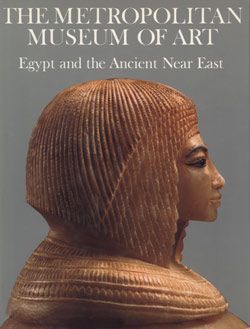Statuette of Arsinoe II for her Posthumous Cult
Ptolemaic Period
The inscription on the back of this figure refers to Queen Arsinoe II as a goddess, indicating it was made after 270 B.C. when her cult was established at the time of her death in by her brother and husband, Ptolemy II. Gilding indicating divinity once covered her face, and traces still remain at the edges of her neckline.
While the overall frontal pose and disposition of the limbs in this small statue follows Egyptian traditions, the cornucopia the queen holds is a Greek divine attribute, and her corkscrew are strongly associated with Hellenistic traditions in Egypt. Features of the depiction – the small Cupid’s bow mouth and the large rounded eyes – are also elements from Greek style. Stylistic comparisons indicate this statue was created in the second half of the second century B.C.
Arsinoe’s deification is part of the phenomenon of ruler cults in the Hellenistic world established to honor leaders, sometimes even while living; statues of the deified ruler might be placed in the temples of other gods. The importance of native goddesses like Isis and Hathor might have encouraged the Ptolemies to establish a prominent queen. Worship of Egyptian pharaonic period queens is rather rare, although there are notable exceptions such as Ahmose-Nefertari
This image cannot be enlarged, viewed at full screen, or downloaded.
This artwork is meant to be viewed from right to left. Scroll left to view more.












